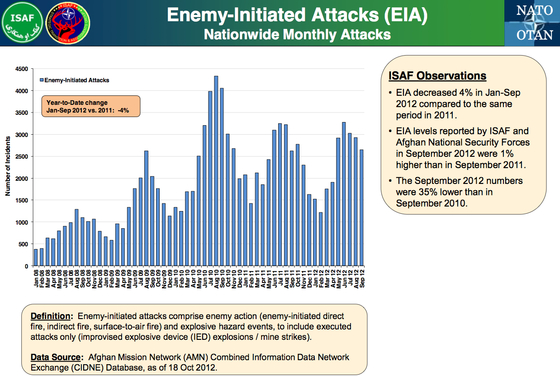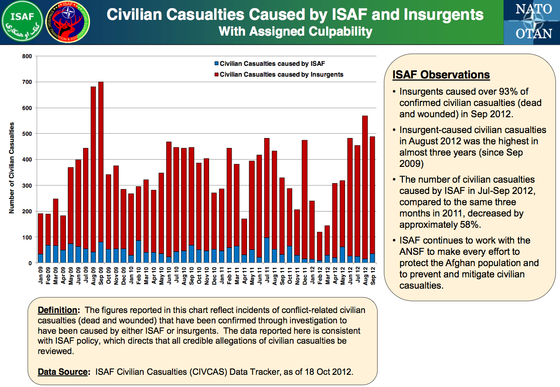On Oct. 23, NATO's International Security Assistance Force (ISAF) released updated figures on the violence in Afghanistan. The data cover the period through September 2012, and as in previous summaries, ISAF compares recent calendar months to the same months in prior years.
The number of enemy-initiated attacks (EIAs) in September 2012 actually increased by a small amount, 1 percent as compared to September 2011. While ISAF does not release precise figures, the number of EIAs in September 2012 exceeded 2,500, according to a bar chart showing trends in the violence.
ISAF defines EIAs as “enemy-initiated direct fire, indirect fire, surface-to-air fire,” as well as executed attacks using improvised explosive devices (IEDs) and mines.
The slight increase in the number of EIAs in September 2012 shows that the Taliban's momentum has not been truly broken, as US and NATO officials have claimed.
The number of EIAs per month remains far greater than in comparable months in 2009, that is, prior to the American-led surge of forces.
After seeing a significant drop off in the number of EIAs in 2011, as compared to 2010, the violence has leveled off in 2012.
The number of EIAs decreased by just 4 percent in the first nine months of 2012, as compared to the same period in 2011. The number of IED attacks fell by 16 percent during that same period.
Counting the number of EIAs only tells part of the story. It ignores the efficacy of the Taliban-led insurgency's attacks.
The insurgency has killed and wounded more civilians in recent months than in comparable months from the two previous years. For instance, the number of insurgent-caused casualties was greater in three of the four months from June through September 2012 than in the same months in 2011. In only July 2012 were fewer civilians killed and wounded, as compared to July 2011.
The number of civilian casualties (killed and wounded) was well over 400 in September 2012, as compared to approximately 300 civilian casualties in September 2011. (ISAF's precise figures remain classified and the figures cited here are based on published bar charts.)
The insurgents' attacks were more deadly in August and September 2012 than in the same months in 2010 and 2011. Only in 2009, prior to the surge, were there more civilian casualties in those same calendar months.
The surge of forces beginning in 2010 made clear progress in southern Afghanistan, where the Taliban's grip on key areas was loosened. A surge of forces never took place in eastern Afghanistan, as was recommended by US military commanders. And the Taliban's overall momentum, as measured by ISAF's figures, was not broken.
For more on ISAF's data and the Taliban-led insurgency in Afghanistan, see LWJ reports: The Taliban's 'momentum' has not been broken and ISAF data show insurgent attacks down, civilian casualties up.

